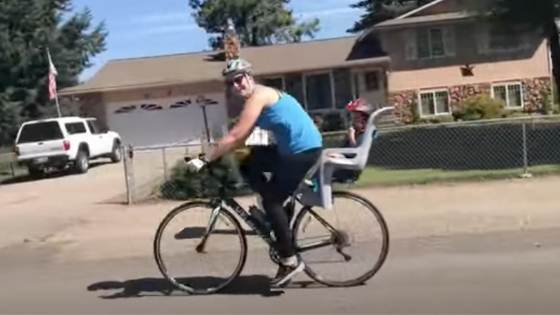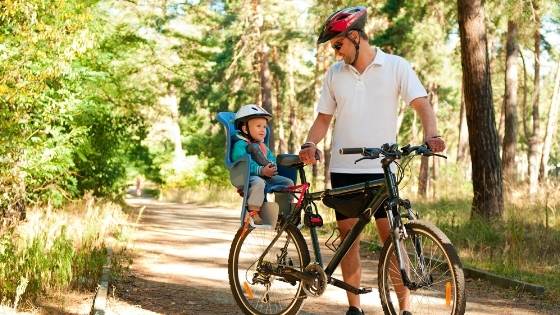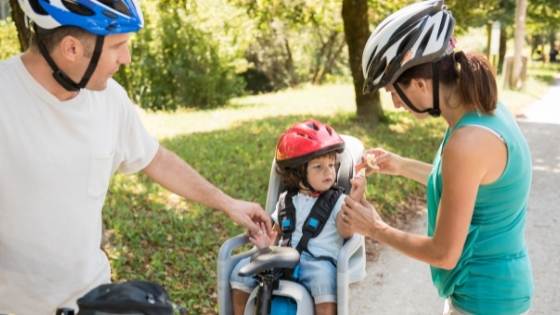
One of my favourite things to do is go out for a bike ride with my son on the back of my bike. He’s two years old, and he loves nothing more than the wind in his hair, cycling along, waving at all the passers-by.
But what if you only have a road bike?
Is it possible to fit a child’s seat to the back of your road bike?
And most importantly, is it safe?
In general, most road bikes are safe to fit a child seat on the back because they have a weight limit on average of 275-300 lbs. Your road bike must have a circle seat tube as the child’s seat’s safety lock can only fit this. Road bikes can become unbalanced quickly, especially with the added weight.
Although it’s perfectly safe to attach a child seat to a road bike, the most challenging aspect of cycling will be the bike’s stability. Road bikes are designed to be cycled on the road or flat surfaces for speed and distance.
They have thinner tyres and no suspension, making them challenging to ride at first.
A toddler in a child seat adds extra weight to the bike and makes it unstable quickly, especially the heavier the child.
But don’t be put off if it’s your only bike because once you get used to the extra weight and balance, you will ride the bike perfectly fine.
You can cycle with confidence knowing your road bike can comfortably take an extra passenger’s weight, and the child’s seat won’t damage your bike or disconnect when cycling.
But before you attach the child seat and head out the door, check out these safety points to make your ride less stressful and more enjoyable.

Table of Contents
How To Ride Your Road Bike With A Child Seat?
1. Check The Weight Limit Of The Child Seat
Before you order your child seat, it’s essential to check the maximum weight limit. Most child seats have a weight limit of around 20kg (44lbs) but don’t forget to add some extra weight for your child’s clothes, helmet, warm coat and shoes.
Generally, most children reach that weight limit by the age of 3 to 4.
The child seat is made from lightweight plastic with a metal frame that attaches to a locking device fitted to the bike seat post.
When installing the child seat, have adequate clearance for your back wheel so it doesn’t hit the bottom of the seat. If you have mudguards fitted, you might have to remove them. Check out the exact child seat I purchased (Amazon Link).
[amazon box=”B0018CX1AA” Title=”Bike Seat For Children, Toddlers, and Kids” description=”Ideal for children up to 40lbs (18kg) which is a child around 3 years old. It fits easily on any road bike, and you can easily remove the child seat when you’re not carrying your youngster. The straps are extremely safe and keep your child in even if they like to move around.”]
2. Go For A Test Ride Somewhere Quiet
The most challenging part of cycling a road bike with a child seat attached is the extra weight. Moreover, the weight is behind you, and your bike will become unbalanced very quickly.
Therefore, before you embark on your route, have a test ride with your toddler in the seat. Select a quiet road or track and test out simple turns and breaking.
Road bikes have thin wheels and tyres, which aren’t great when your child suddenly decides to move left or right. You have to put a lot of extra effort into keeping the bike straight.
Therefore, I used my street to ride up and down for 5 minutes, getting used to the added weight. Once you have built your confidence, it’s time to hit the open road.

3. Never Clip Your Feet Into The Pedals
When cycling with my son in the child seat, my only fear is falling off the bike with him still fastened. The risk is increased if your feet are clipped into your pedals.
I purchased some non-clippable flat pedals with the child’s seat (Amazon Link to the ones I bought).
When I take him out on a ride with me, I always remove the pedals that require me to clip into and replace them with flat pedals.
I wear regular training shoes, that way I can put my feet down immediately if I become unbalanced or feel the bike is unstable. When you are not clipped into your pedals, your confidence to cycle on the road increases.
If you need to stop, always put your foot down on the sidewalk or curbside first. Suggesting, if the bike does fall, you’re not stumbling onto moving traffic.
4. Keep The Little One Warm
My biggest mistake on my first journey wasn’t keeping the little one nice and warm. When we begin to cycle, we naturally warm up because we expend energy, but your toddler at the rear is just a passenger.
After cycling for 15 minutes, I stopped to check him, and to my naivety, he was cold. I didn’t wrap him up enough.
Therefore, my big tip is to wrap them up extra warm. You can always take something off if they get too hot.
I find their hands and face get the coldest, especially if you are cycling into the wind. Your body does protect them from a lot of the wind.
Furthermore, high visibility clothing also helps so people can see you coming.
Yellows, oranges or reds stand out the most.

5. You Both Need Bike Helmets
I never go on a bike ride without a helmet because I’ve heard so many horror stories. I see families out riding with their children in a child seat, and no one has helmets on.
They think because they are cycling at slow speeds, they won’t hurt themselves. But a bike helmet will protect you from falls and other road traffic collisions.
You must both wear a bike helmet, and if the helmet doesn’t fit your child, then don’t go out on the ride. My son loves wearing the helmet because it is something new and different.
However, if you notice your little one disapproves, give it to them days before your ride. That way, they will play with it and get used to it.
My son has a little bike that he plays with around the house, and he always wearing his bike helmet.
There are no issues when we go out together because he’s now on daddy’s bike with his helmet.
I’ve put a link to the bike helmet my son wears here (Amazon link).
6. Avoid Busy Roads And Plan Your Route
When I ride my road bike without my son, I always cycle on the roads. But you will soon be less confident when you have a child with you.
Thus try and bypass busy streets and cycle in places like cycle tracks or paths. Heavy traffic makes the entire experience stressful, the traffic makes it difficult to hear, and it is not enjoyable.
I always plan my route before going anywhere.
I highlight the busy sections of the road so I can get prepared for any distracted motorist. I always ride slow and give drivers plenty of notice when I’m turning.
I never take any risks and wait longer to turn or cross a section of the road.
High visibility clothing, lights and a bell are essential if you are cycling on the road with your child in toe. Take advantage of cycle lanes, and if you feel uncomfortable, cycle on the street or sidewalk.

7. Cycle With Your Partner Or Friend
The first couple of rides will be the most daunting and nerve-racking. Therefore, I went cycling with my wife.
She cycled behind us, which gave me confidence and trust because I would ask her if everything was ok with my son and the bike. Riding together as a family is so fun, making the whole ride worth the time outdoors.
Although, If you are cycling on the road, if you have someone else riding behind, cars and other road users can see you better.
They have to slow down a lot more because they have two bikes to pass.
In fact, there is nothing stopping you from cycling side by side as two bikes abreast are road legal.
Don’t worry about other road users if they have to wait longer to pass you, it’s safer for you.
8. Fit A Bike Mirror And Bell
When you eventually build the confidence to ride on your own with the little one, buy yourself a little mirror for your handlebar so you can see them without having to turn around.
Cycling and turning round are the hardest things to do. To prevent your bike from becoming unbalanced, check the mirror to see your child is still enjoying the ride.
Here is the exact mirror I use (Amazon Link).
Finally, buy a bell unless your road bike already has one fitted. When you get off the roads and cycle in paths and lanes, there are a lot more people walking around.
Trying to navigate around them is difficult with a baby in tow.
Therefore, a bell will let people know you are coming, and most of the time, they will move out of your way, making it easier for you.
Weaving in and out between people isn’t fun, and the pedestrians won’t be happy.
